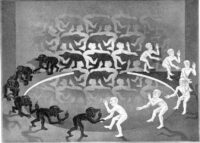When I gaze up into the trees from my backyard I’m always struck by the ways they grow into and towards the light. A very large red-barked Eucalyptus over nine-stories tall in my neighbor’s yard dominates the sky from down below, its silver-colored leaves shimmering in the sunlight. In my own yard, an old Black Walnut with a trunk diameter over three-feet wide spreads its leafless winter canopy across the entire fifty-foot width of the yard, its bare branches revealing a pattern designed to maximize exposure to the sun.
Conventionally, science refers to such plant behavior as phototropic–light-seeking growth patterns dictated by genetic disposition. This observation, however accurate from a scientific standpoint, misses the heart of the nature of life as a creatively adaptive anti-entropic force that powerfully seeks to thrive, even in the most adverse conditions. A full appreciation of life-force includes wonder — at its stamina, inventiveness, persistence, diversity and strength.
Even wonder at all this still misses, for at its heart life displays something beyond science, words or poetry. Life is an expression of love.
The force of love I have in mind is not the sentimental sort emotional people enjoy, though even the roots of sentimental love sit deeply embedded within a greater force of love. I’m speaking about the force of love that brings and binds quarks together and from there the larger particles that self-assemble into atoms, molecules, protein chains, cells, bodies and the myriad forms of life.
Theoretical physicists seek a Grand Unified Theory to explain emergence from the void, and the late Stephen Hawking spent his life looking for an explanation of the force that unifies the quantum world of the very smallest we cannot see with the ordinary world of the very largest that we can observe. He knew, intuitively, that a single force underlies all things, but science is loath to call it love. Love, after all, sounds anything but scientific; and yet, this love spans the universe.
Love, of course, is a mystery — The Mystery. Just as the trees in my yard long for the sun, so life itself displays great longing. The force of love beckons living things–urging, compelling, yes, even demanding. It is beneath hunger and thirst, attraction and rejection, happenstance and plans. The force sustains and destroys in ways that human beings can sometimes observe but never entirely explain or understand. Thus the great mystery of love is and has been called by many names and also described in many ways, but call it as you will, as the Taoist’s say, the Tao that can be named is not the Tao.
And yet there’s more. The force of love is instantaneous, timeless and unbound by space–like gravity. This is The Mystery that so fascinated Hawking, who spent years trying to understand the nature of Black Holes, the cosmic structures absorbing–should I say loving–space-time itself into a dimensionless singularity. It is this same force, Hawking knew and sought to understand, that binds quarks together and forms the entire fabric of the seen and unseen cosmos. If you choose, it’s possible to feel the force of love right now; it’s in you, it’s outside of you–it is you. It’s not a moment to moment, fragmentary thing; it’s all-of-it right now.
So there it is, the view from my back yard.





Be First to Comment